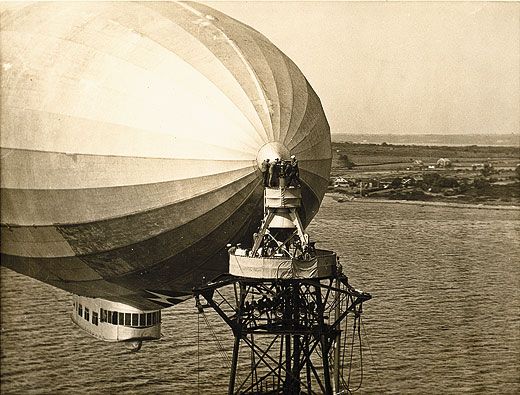Last One Out, Shut off the Helium
Fifty years ago, the Navy ended its lighter-than-air program.
/https://tf-cmsv2-smithsonianmag-media.s3.amazonaws.com/filer/Moments_0811_1_MAIN.jpg)
Airships are stately craft that carry with them a special kind of hauteur, one that makes them, like whales and manatees, endearing. For U.S. Navy personnel who became part of the service’s lighter-than-air (LTA) arm, the decommissioning 50 years ago this November of the last of the airships was both poignant and bitter. Not everyone who served in the blimp fleet loved the big gasbags, but for those who did, love was not a strong enough word for what they felt about their airships.
A press release from the Department of Defense issued on June 26, 1961, spells out the details of the final mile for LTA. During the war, airships patrolled up to three million square miles of ocean for U-boats. After the war ended, all the overseas patrols came home, and the Pacific squadrons were either shut down or moved east. The fleet went from a wartime high of some 125 airships to 10, and about 725 naval personnel and some 450 civilian employees. When the end came, Fleet Airship Wing One, with Patrol Squadrons One and Three, all based at U.S. Naval Air Station Lakehurst, in New Jersey, were the only units left.
What stung airship partisans then—and still does today—was their belief that the decision to phase out these magnificent aircraft was irrational. They had numbers to prove it. What fixed-wing craft could maintain a watch position in a howling Atlantic winter’s gale for days on end? Which air arm had blunted single-handedly the submarine war the German navy had waged in the Atlantic? Had it not taken five fixed-wing early-warning radar aircraft to do the work of one airship? And had not the airship Snow Bird won the 1958 Harmon Trophy for a record flight of 9,448 miles without refueling?
But in high winds and thunderstorms, blimps were vulnerable, and when they were moored, they were nearly helpless. To dyed-in-the-wool airship believers, these were mere challenges to be overcome—certainly not a reason to terminate the entire program. So in the timeless manner of all bureaucracies, the Navy blamed the program’s end on a “shortage of funds,” along with “the increasing capability of helicopters and fixed-wing aircraft” to perform the blimp’s missions.
What the press release didn’t say was that airships did nothing to enhance the Navy’s supreme icon of warfare: the aircraft carrier. Career Navy men went to Annapolis, made the choice between aviation or battleships (and later, nuclear submarines), grabbed the first combat tour they could find, came home and attended War College, then commanded a carrier before lining up for a slot at the Pentagon. Blimps didn’t need carriers, and commanding one would not put a row of stars on one’s collar.
The Navy launched its LTA program by awarding its first contract for an airship—$45,636.25—to the Connecticut Aircraft Company in June 1915. The program missed its 50th anniversary by just four years. In the end, eight of the remaining blimps were disassembled, a process taking 10,000 hours, and two were maintained briefly for research as flying wind tunnels and in support of NASA. In March 2006, the Navy got back in the LTA business, buying the MZ-3A airship from the American Blimp Corporation of Hillsboro, Oregon. Crewed by contract civilians, the airship is intended for research: among other goals, to investigate what roles airships are good for.
